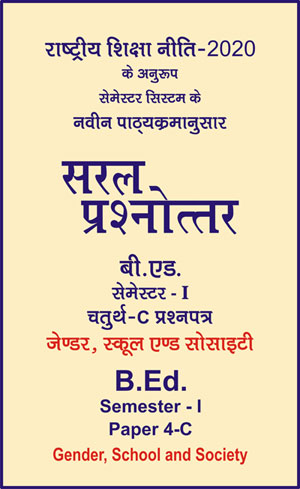|
बी एड - एम एड >> बी.एड. सेमेस्टर-1 प्रश्नपत्र-IV-C - जेण्डर, स्कूल एण्ड सोसाइटी बी.एड. सेमेस्टर-1 प्रश्नपत्र-IV-C - जेण्डर, स्कूल एण्ड सोसाइटीसरल प्रश्नोत्तर समूह
|
5 पाठक हैं |
||||||
बी.एड. सेमेस्टर-1 प्रश्नपत्र-IV-C - जेण्डर, स्कूल एण्ड सोसाइटी (अंग्रेजी भाषाा में)
Chapter 7 - Stereotypes about females prevalent in the Society, Media and Literature
Question- Throw light on the stereotype prevailing in the society towards women.
Related Short Answer Questions
- How are girls traditionally treated?
- Despite modernity, what do women have to face?
Answer -
Since ancient times, the status of girls, including adolescent girls, has been lower than that of boys in the household, especially in societies where the marriage of girls requires the family to pay dowry and where girls are allowed to marry. Later she is sent to her husband’s house to live. Recent research shows that adolescent girls are still forced to endure many types of violence and harassment due to social discrimination. These discriminations include - sexual violence, forced and early marriages, drop out of school, and death while giving birth. Early marriage and pregnancies can have a bad effect on the health of girls. This may hinder girls’ ability to take advantage of education or job opportunities. In many cultures, daughters-in-law and unmarried women, widows and women who have been abandoned by their husbands do not enjoy equal status because they do not fit into the framework of constructed identities designed for them.
Violence against women with disabilities can be in many ways similar to violence against women with disabilities. However, women with disabilities are also vulnerable to other forms of abuse. For example, the removal of aids or adaptations from these women; To use these aids to cause bodily harm to women; Giving hermore or less medicines than necessary; Refusing or delaying assistance, ill-treating her while helping her, sexually assaulting a woman while using aids; alleging the fact that the woman deserves to be abused, controlling financial resources and benefits, patronizing her under her ability to do something for herself; etc etc.
Historically, women have always been working but still the work done by them in the home has always been invisible and they have always been given a conservative attitude and faced discrimination. As a result of rapid industrialization, more priority was given to the work done outside the family circle.
Although working-class women are often able to sell their domestic skills to earn money, they still have to work at home to take care of their families when they return home. During a seminar, a professor once shared his experiences and said that when he returns home, he asks his mother what the mother did throughout the day and the mother’s answer to this is always “nothing has been done”.
It is also necessary for those women who are financially independent to get a job and become financially independent. This double work or dual job (even at home, and outside for pay) places women in an unprofitable position compared to men. Various scholars have analysed and discussed possible explanations for this duplicity of work. The gender division of labour is considered a direct result of patriarchy and capitalism. Although many Marxist feminists argue that capitalism determines the need for oppression of women in the market. But there have been significant disagreements about whether household chores contribute to the added value. The availability of time and ideology (Shelton and John, 1996) have also been the explanations for domestic labour in the society.
Although both men and women go out of the house to do paid work, women continue to do most of the unpaid work at home. Even after modernity, a change in this orthodox ideology is becoming inevitable. Not making the condition of women pathetic, everyone should be given due respect and affection.
|
|||||













